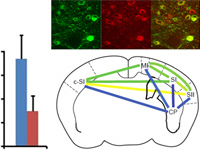Heparan sulfate (HS) is a heterogeneous, cell-surface polysaccharide critical for transducing signals essential for mammalian development. Imaging of signaling proteins has revealed how their localization influences their information transfer. In contrast, the contribution of the spatial distribution and nanostructure of information-rich, signaling polysaccharides like HS is not known. Using expansion microscopy (ExM), we found striking changes in HS nanostructure occur as human pluripotent stem (hPS) cells differentiate, and these changes correlate with growth factor signaling. Our imaging studies show that undifferentiated hPS cells are densely coated with HS displayed as hair-like protrusions. This ultrastructure can recruit fibroblast growth factor for signaling. When the hPS cells differentiate into the ectoderm lineage, HS is localized into dispersed puncta. This striking change in HS distribution coincides with a decrease in fibroblast growth factor binding to neural cells. While developmental variations in HS sequence were thought to be the primary driver of alterations in HS-mediated growth factor signaling, our high-resolution images indicate a role for the HS nanostructure. Our study highlights the utility of high-resolution glycan imaging using ExM. In the case of HS, we found that changes in how the polysaccharide is displayed link to profound differences in growth factor binding.
